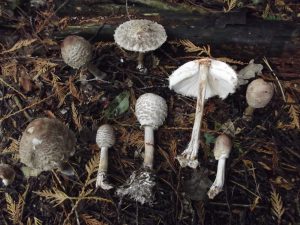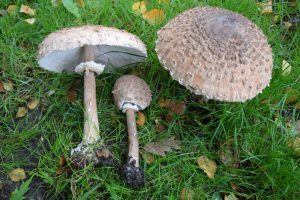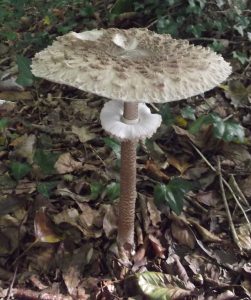Email: geoff@geoffdann.co.uk
29/09/2017
The parasols used to be so simple. One big one with a stripey stem, one small one with a plain stem that turned red when you cut it open, and also made some people violently sick. They were the Parasol Mushroom (Macrolepiota procera) and the Shaggy Parasol (Macrolepiota then Chlorophyllum rhacodes). And there were a couple of others that weren’t very common, but seemed reasonably easy to identify, and had English common names.
Everything has since all become rather more complicated. The old Shaggy Parasol has been split into three, two of which were given new English names while my book was being put together (Brown Parasol – Chlorophyllum brunneum and Conifer Parasol – Chlorophyllum olivieri). The Conifer Parasol in particular has been throwing people astray this autumn, with many mistaking it online for a Macrolepiota. This situation is not made any easier by the presence of at least two other Macrolepiota species, both of which have caps more similar to the Chlorophyllums than that of M. procera.
One of these has turned up quite a few times, both on my own travels and in posts from southern England online. It is supposedly very rare, but I am beginning to suspect it is not as rare as all that. Today I came across it growing on a grass verge right next to a busy main road, not far from a school, and most of the fruit bodies had been disturbed by passers-by. It doesn’t have an English common name, and there wasn’t enough space to include it in my book (or it would have been given one at the time). Maybe it is about time it was given one, and in this case it is there is a very obvious candidate for a name. Its specific epithet is fuliginosa, which means “sooty”. Since this rather aptly describes its cap, at least relative to its better-known relative, “Sooty Parasol” is surely the odds-on favourite. I have suggested it to the British Mycological Society, and will be using this name until/unless informed that a decision had been made to call it something else. Regarding identification, another difference is the stem, which is more “marbled” than “snakeskin”. It also tends to turn up more often in woodland than procera does.
They have an even rarer relative, which I believe I may have come across a couple of years ago (although having only found it once and relying on rather minimal information about it, I am far from certain that this picture really is the species concerned). This fungus also has a descriptive Latin name – Macrolepiota fuligineosquarrosa. “Squarrosa” means “scaly” in Latin (I think!), so perhaps this one should be called “Scaly Sooty Parasol”. Though I think I’ll wait for the first suggestion to be accepted before offering another…
(Update: Liz Holden from the BMS likes “Sooty Parasol”, but perhaps fuligineosquarrosa is going to end up just being “Scaly Parasol”, which is admittedly less clunky.)
They are both just as edible and tasty as a normal Parasol Mushroom.




I have a patch of what I think are Shaggy Parasols that come up in my garden every year. I haven’t had the courage to try eating them, but your post has confirmed the wisdom of my decision! Its so hard to be 100% sure of their ID. BTW, I have your “Edible Mushrooms” book, and it has been a great help to me.
Hi Mark. Yes, they can be a bit tricky, but unless they are really quite small then there isn’t much dangerous you can mix them up with (it is the smaller Lepiotas that are deadly). But there is also the additional problem of some people being violently allergic to them, so it is always wise to try just a little bit first. Geoff
Hi Geoff
Do you think (as Fungi of Temperate Europe appears to) that the tummy upsets all arise from Ch. brunneum (just ID’d as a Shaggy, or confused with Ch. rhacodes), and that Ch rhacodes is just a good edible like Macrolepiota sp.? Or that the tummy upsets occur is a certain proportion of all Chlorophyllum eaters?
I don’t know.
Hi!
So I just read your article and starter wondering if I ever encountered sooty parasol thinking it’s a normal macrolepiota procera
Do you think those might be sooty parasols?
Found in Poland in 2020
https://photos.app.goo.gl/PX8q4S4u9cbhuk4a6
Thank you
They do look like it, yes.